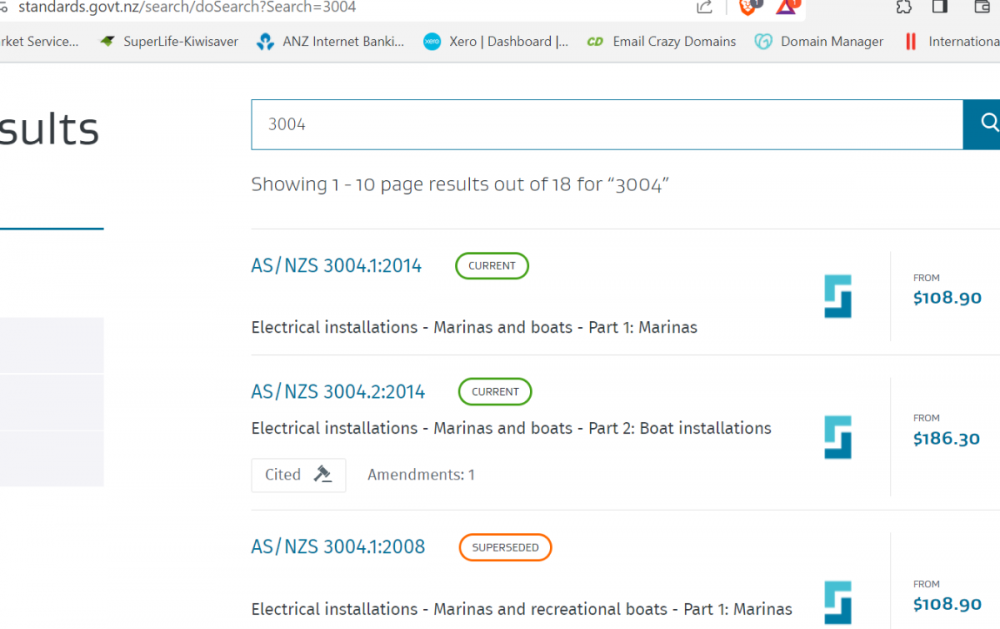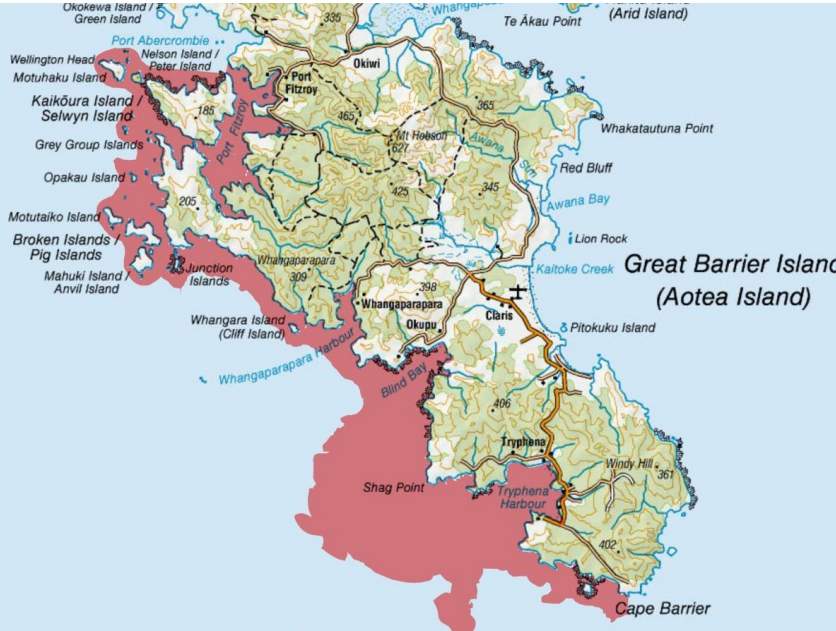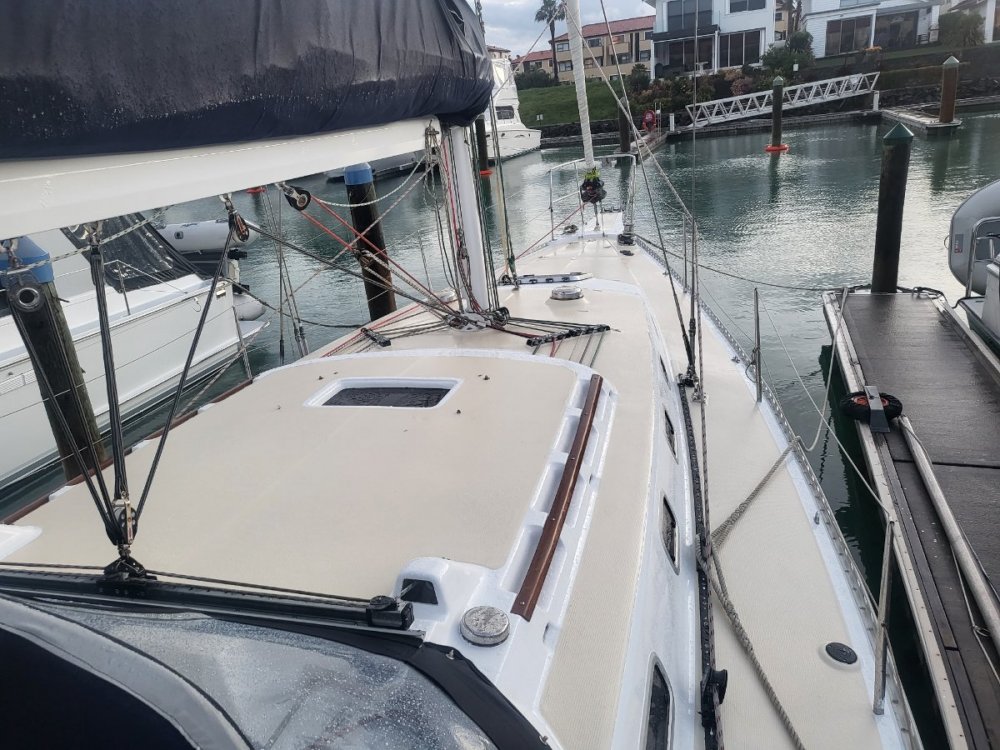-
Content Count
8,505 -
Joined
-
Last visited
-
Days Won
244
Content Type
Profiles
Media Demo
Forums
Gallery
Calendar
Store
Posts posted by Island Time
-
-
Alan is still around, and a member at Gulf Harbour YC. I could probably get you a ph number if you wish?
-
Where?
in MarineTalk
If you dont know what it is on an electronic chart, click on it, and it will tell you. Chart 001 is still available, see attached...
-
 1
1
-
-
So it's possible that the threads are galled. If so, they need to be replaced. So;
Support the rig with a halyard. Take the rigging screws off completely, clean, inspect and if ok lubricate and ensure they are free to move by hand when unloaded. If all that is ok, re-install...
-
 2
2
-
 1
1
-
-
What do you want? I could bring one to mahurangi tomorrow night?
-
Tie a Swiss seat - works ok, but not real comfortable !
-
You mean mainsail slides and track, headsail foil or what?
-
Boom Brakes properly used slow the boom in a gybe, without the main doing so - but it's hard to find a boom brake (IMO the best one is the dutchman boom brake) for larger mainsails - and it loads the boom highly at the kicker fitting...
-
 1
1
-
-
Hmm, my boat the boom is well clear or your head, and the mainsheet is not in the cockpit. = no helmet needed

-
Yep, 7 now, and I want one for me, so 10 left... at 5 I'll order another box...
-
Oh, and I got 18, 4 gone in 4 hours! So maybe be in if you want some from this shipment!!
-
1 hour ago, Clipper said:
Cool. Just ordered a roll. Ive heard great things - any advice on how to use?
Full Instructions are here https://marinehowto.com/bed-it-tape/ but basically clean the area to be used, and put it on the surface. Bolt/screw down the hardware and trim of the excess that squeezes out. You may have to do the trim bit again a few weeks later. That's it - as bolted down, it squeezes out and seals around fastenings, although I tend to put some around the top of bolts and countersinks as well.
-
 1
1
-
-
OK, I've finally been able to source and have in stock the original Bed It Tape, for bedding deck fittings. The first shipment (18 rolls, that's a case) arrived today, so ex stock in NZ for the 1st time. $50 + GST per roll - it's 15m long, 13mm wide and 1,6 thick. This is all I use now and it's awesome!
Link is here https://www.neptunes-gear.com/product/marine-bedding-tape/
-
7 hours ago, CarpeDiem said:
Sorry IT.
The citations are for the Maritime Act, specifically rule 40.
Rule 40 does not apply to pleasure craft. It applies to commercial craft in survey.
If you can show me a citation that applies to pleasure craft I will get off my soap box.
CD for me, the Electrical inspector I use says the 2014 version is the current one. The NZ Govt Website says it is the current one. I linked to the Govt website that shows this. Here is the screenshot.
It shows the 2008 standard as superseded. That is sufficient for me. If you wish to disagree, you of course are free to do so. Potentially, IMO, you could have to do so in court.
The "connectable installation" section is not present in this version. So ALL boats must comply, except as excluded (small boats with only Alts/Magneto's and lights, no real electrical systems)
Again, the standards are not retrospective - if your boat has non compliant systems, that's ok, but anything new must comply.
This is also the opinion of the local electrical inspector here.
-
14 hours ago, CarpeDiem said:
Hi IT, sorry I did not explain myself clearly - my bad.
You are referring to the standard - I am referring to the legislation that gives legal force to the standard.
Without legislation, (or a private body**), that requires the standard be followed, the standard has no effect.
Per the link you provided, AS/NZS3004:2014 is only legislated by the Maritime Act and Maritime Rule 40E - this rule does not apply to private sailing vessels. It applies to commercial sailing vessels that are in survey.
The standards.govt.nz site does not list any legislation that gives force to AS/NZS3004:2014 on private sailing vessels.
There is legislation that gives force to the standards predecessor, AS/NZS3004:2008 - this is the Electricity Safety Regulations 2010. That legislation, legally requires, that ships connected to shore power, (or with self generation), must comply with the 2008 standard. But not the 2014 standard.
In 2019 there was a MBIE working group which found that the reference to the 2008 standard in the legislation should be updated to the 2014 standard - but that has not occurred yet - the legislation has not been amended.
** any private body, is of course, allowed to say that they only will accept the 2014 standard.
Eg, as an electrician in business you are perfectly entitled to say "I will only do work that meets the 2014 standard".
We have discussed many times on this forum the same thing with the gas standard. The Gas Standard says that it does not apply to installations before that standard was produced. But good luck finding a gas fitter that will sign off on your installation being compliant to the previous standard... I doubt you will find one...
As of today I cannot find any legal requirement to comply with AS/NZS3004:2014 on pleasure craft. It may become a requirement in the future if the legislation is ever amended.
Even if one were just to assume that v2014 automatically trumps the v2008 reference (which I think would be a reasonable assumption) in the regulations, the regulations still do not apply to pleasure vessels without AC.
Nope, Sorry. The Link i provided gives the current legal citings buy the courts making the version I linked to the current legal rules. I agree that the "standards" or not law until they are citied by the courts. That's why the link also states that this is the "Current" legal version. If you wish to try to prove this in the courts, feel free.
Even if you could prove it's the older version, the new one, I understand, is only months away (2020 version I believe, currently still under review), and they there are more restrictions coming. I would point out though, that the standards ARE NOT RETROSPECTIVE, so if it was ok when installed, it's ok until modified/rebuilt.
-
On 30/11/2023 at 7:36 PM, CarpeDiem said:
Thanks. I find it strange that 2008 is the only version referenced in the regulations.
Section 3 of the Electrical Safety Regulations 2010, which is the legal instrument that gives authority to the as/nzs standard states that:
the regulations do not apply to pleasure vessels unless they have connectable installations.
connectable installation is one that is designed or intended for, or is capable of, connection to an external power supply that operates at a nominal voltage between 90 and 250 volts AC at standard low voltage.
The above clauses in the regulations indicate to me, that if you don't have AC, (or AC self generation including inverters), then the regulations do not apply to a pleasure vessel.
Unfortunately, that is NOT the current standard. See here https://www.standards.govt.nz/search/doSearch?Search=3004 and you can see the 2014 version is the current one, and if you click on the "Cited" bit, you get a list of court citings.
And this one has modified that clause to say "1 This Standard is not intended to apply to small boats equipped with a battery supplying circuits for engine starting and navigation lighting only that is recharged from an inboard or outboard engine driven alternator."
So the "connectable" clause has gone...
-
The Standard I'm using is AS/NZS 3004.2:2014 Electrical installations„Marinas and boats
My understanding from the local electrical inspector is that this version has been sighted by the court, which makes it law. It is also the one on the official website: https://www.ewrb.govt.nz/for-registered-electrical-workers/your-licence/access-nz-standards-for-all-electrical-installations-and-appliances/
The 2018 version has not been sighted, and likely will not be, as it had too many issues and the replacement is, I understand, not too far away.
There is nothing in the reg that says a boat is only covered if it is connected to shorepower.
-
-
I know there are some who wish to build their own battery banks. That's fine, but consideration should be given to the NZ electrical regs. Lithium - LiFePo4 (really the bets for marine, and very safe) MUST have audio and visual alarms fitted to warn of an impending disconnect, BEFORE it happens (for whatever reason). This is the stumbling block for most "drop in" solutions.
Multiple chemistry battery banks and not acceptable under the standards. That does NOT mean you can't have LiFePo4 house batts and Lead Acid start batts.
Be aware that a DIY (or any) install that does not meet the NZ regs (or those of flagged state if not NZ) very likely voids your insurance policy. Read the fine print on yours!
Alternator/Charge system protection is not difficult - an Argofet splitter (FET based not Diode) and preferably an alternator protection device (Balmar and Sterling have good ones for a few hundred) will protect an alternator.
Also note that a properly installed and configured BMS will NEVER need to do an emergency disconnect, unless something has failed. A properly installed and configured system will shut off charge sources when batts are full, BEFORE emergency shut off. It will also turn them back on when lower limits are reached.
The regs are like they are to try to prevent "Dark Ship" - where without warning, suddenly no electrical power, navigation gear, lights etc.
Modification to an alternator is not expensive or difficult, but good external regulators are reasonably expensive. The real cost is not the batts for LiFePo4, they are not really much more than good VRSLA's. The additional cost in extras ( BMS units, remote battery relay, Argofet or DC-DC, etc) can be a couple of thousand. It is very realistic to get a good working compliant system on a DIY build/Install for 3-4k.
Lead Carbon does not compare (IMO) . It's heavy, 30% of Capacity max charge rate is typical. LiFPo4 is light, and charges at 1c - 100% of capacity is typical.
As a professional in this area, I will not build a system for a customer that does not comply with the NZ standards.
If you are considering battery chemistries, please read the Marine How To Article already posted above https://marinehowto.com/drop-in-lifepo4-be-an-educated-consumer/ for some understanding of the topic.
Oh, and sorry to the posters above with overkill or JBD BMS's - Ive not seen one of those that complies with the regs for NZ - No external alarms etc. I'd be happy to be corrected on this if you've found one though, its a rapidly changing world...
-
 1
1
-
-
8 hours ago, K4309 said:
Does anyone know the design displacement of a Whiting 40?
Asking for a friend, needs to be under 10t to allow hauling at our club.
Noting that if cruising weight is over 10t it could be unloaded to get down to the permitted weight (i.e. drop water tanks). Any actually design data would be ideal, but general estimates helpful.
Bit heavier than the Farr, but around 8 metric tons. + Gear. But it will be under 10...
-
 1
1
-
-
-
The NZ Coastguard tickets are NZ only, virtually no recognition anywhere except here. The RYA tickets are widely accepted - and are what the NZ coastguard issues now. Some RYA tickets can have STCW endorsements for commercial use. ICC is not a hard test... RYA tickets are much more complex...
NZ Coastguard now do both;
https://www.boatingeducation.org.nz/courses/42/international-certificate-of-competence-icc/
I suggest you call them, tell them what you have and see what (if anything) they will cross credit.
-
 1
1
-
-
No. Nowhere near RYA yachtmaster coastal. Sorry.
-
On 14/11/2023 at 9:27 PM, Ex Machina said:
Looks very nice . Can you adjust the traveller from the Nav area ?
Yes. Everything from cockpit...
-
Well, Building on this, I've just finished the decks and structure - now the whole boat has been painted (outside) bottom of keel to top of mast. Again roll and tip, then Kiwigrip over the molded glass non skid. Took off "most" of the deck gear to do it... New Teak timber work as well, some not re-installed yet.
-
 3
3
-






Coastal cruiser for NZ waters
in MarineTalk
Posted
What others have said here is good. Please take this as intended - to help show what's required. Cat one is expensive - not in itself, (inspection is $115) but in preparing a yacht properly for Blue Water. That being said there is little I wouldn't do that is in the regs before leaving
Read this stuff..
https://www.yachtingnz.org.nz/sites/default/files/2022-03/YAC240587 YachtingNZ Safety Regulations - Mar2022 - ONLINE_0.pdf
https://www.yachtingnz.org.nz/sites/default/files/2018-10/Safety Inspectors Checklist.pdf
It will give you some idea. Most people (almost all) severely underestimate the time and effort required to do this. You may need to take an experienced crew member with you on your first passage. If you can find a boat that has recently been in cat one, that has great benefits!